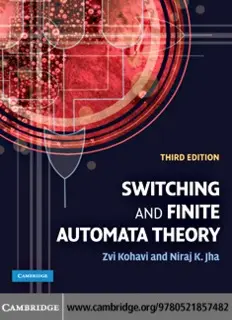
Switching and Finite Automata Theory, Third Edition PDF
Preview Switching and Finite Automata Theory, Third Edition
This page intentionally left blank ii SwitchingandFiniteAutomataTheory Understandthestructure,behavior,andlimitationsoflogicmachineswiththis thoroughlyupdatedthirdedition. Newtopicsinclude: (cid:2) CMOSgates (cid:2) logicsynthesis (cid:2) logicdesignforemergingnanotechnologies (cid:2) digitalsystemtesting (cid:2) asynchronouscircuitdesign The intuitive examples and minimal formalism of the previous edition are retained,givingstudentsatextthatislogicalandeasytofollow,yetrigorous. Kohavi and Jha begin with the basics, and then cover combinational logic design and testing, before moving on to more advanced topics in finite-state machinedesignandtesting.Thetheoryismadeeasiertounderstandwith200 illustrativeexamples,andstudentscantesttheirunderstandingwithover350 end-of-chapterreviewquestions. ZviKohaviisExecutiveVicePresidentandDirectorGeneralatTechnion–Israel Institute of Technology. He is Professor Emeritus of the Computer Science DepartmentatTechnion,whereheheldthepositionofSirMichaelandLady SobellChairinComputerEngineeringandElectronics. NirajK.JhaisaProfessoratPrincetonUniversityandaFellowoftheIEEEand ACM.HeisarecipientoftheAT&TFoundationAwardandNECPreceptorship Award for research excellence, the NCR Award for teaching excellence, and Princeton’sGraduateMentoringAward. i ii Switching and Finite Automata Theory Third Edition Zvi Kohavi Technion–IsraelInstituteofTechnology Niraj K. Jha PrincetonUniversity iii CAMBRIDGE UNIVERSITY PRESS Cambridge, New York, Melbourne, Madrid, Cape Town, Singapore, São Paulo, Delhi, Dubai, Tokyo Cambridge University Press The Edinburgh Building, Cambridge CB2 8RU, UK Published in the United States of America by Cambridge University Press, New York www.cambridge.org Information on this title: www.cambridge.org/9780521857482 © Z. Kohavi and N. Jha 2010 This publication is in copyright. Subject to statutory exception and to the provision of relevant collective licensing agreements, no reproduction of any part may take place without the written permission of Cambridge University Press. First published in print format 2009 ISBN-13 978-0-511-65824-2 eBook (NetLibrary) ISBN-13 978-0-521-85748-2 Hardback Cambridge University Press has no responsibility for the persistence or accuracy of urls for external or third-party internet websites referred to in this publication, and does not guarantee that any content on such websites is, or will remain, accurate or appropriate. Contents Preface pagexi Part1 Preliminaries 1 Numbersystemsandcodes 3 1.1 Numbersystems 3 1.2 Binarycodes 10 1.3 Errordetectionandcorrection 13 Notesandreferences 19 Problems 20 2 Sets,relations,andlattices 23 2.1 Sets 23 2.2 Relations 25 2.3 Partiallyorderedsets 28 2.4 Lattices 30 Notesandreferences 33 Problems 33 Part2 Combinationallogic 3 Switchingalgebraanditsapplications 37 3.1 Switchingalgebra 37 3.2 Switchingfunctions 44 3.3 Isomorphicsystems 52 3.4 Electronic-gatenetworks 57 ∗3.5 Booleanalgebras 58 Notesandreferences 60 Problems 61 v vi Contents 4 Minimizationofswitchingfunctions 67 4.1 Introduction 67 4.2 Themapmethod 68 4.3 Minimalfunctionsandtheirproperties 78 4.4 Thetabulationprocedureforthedeterminationofprimeimplicants 81 4.5 Theprimeimplicantchart 86 4.6 Map-enteredvariables 93 4.7 Heuristictwo-levelcircuitminimization 95 4.8 Multi-outputtwo-levelcircuitminimization 97 Notesandreferences 100 Problems 101 5 Logicdesign 108 5.1 Designwithbasiclogicgates 108 5.2 Logicdesignwithintegratedcircuits 112 5.3 NANDandNORcircuits 125 5.4 Designofhigh-speedadders 128 5.5 Metal-oxidesemiconductor(MOS)transistorsandgates 132 5.6 AnalysisandsynthesisofMOSnetworks 135 Notesandreferences 143 Problems 144 6 Multi-levellogicsynthesis 151 6.1 Technology-independentsynthesis 151 6.2 Technologymapping 162 Notesandreferences 169 Problems 170 7 Thresholdlogicfornanotechnologies 173 7.1 Introductoryconcepts 173 7.2 Synthesisofthresholdnetworks 181 Notesandreferences 200 Problems 202 8 Testingofcombinationalcircuits 206 8.1 Faultmodels 206 8.2 Structuraltesting 212 8.3 I testing 220 DDQ 8.4 Delayfaulttesting 224 8.5 Synthesisfortestability 232 8.6 Testingfornanotechnologies 250 Notesandreferences 254 Problems 257 vii Contents Part3 Finite-statemachines 9 Introductiontosynchronoussequentialcircuitsand iterativenetworks 265 9.1 Sequentialcircuits–introductoryexample 265 9.2 Thefinite-statemodel–basicdefinitions 269 9.3 Memoryelementsandtheirexcitationfunctions 272 9.4 Synthesisofsynchronoussequentialcircuits 280 9.5 Anexampleofacomputingmachine 293 9.6 Iterativenetworks 296 Notesandreferences 300 Problems 300 10 Capabilities,minimization,andtransformation ofsequentialmachines 307 10.1 Thefinite-statemodel–furtherdefinitions 307 10.2 Capabilitiesandlimitationsoffinite-statemachines 309 10.3 Stateequivalenceandmachineminimization 311 10.4 Simplificationofincompletelyspecifiedmachines 317 Notesandreferences 330 Problems 330 11 Asynchronoussequentialcircuits 338 11.1 Modesofoperation 338 11.2 Hazards 339 11.3 SynthesisofSICfundamental-modecircuits 346 11.4 Synthesisofburst-modecircuits 358 Notesandreferences 363 Problems 365 12 Structureofsequentialmachines 372 12.1 Introductoryexample 372 12.2 Stateassignmentsusingpartitions 375 12.3 Thelatticeofclosedpartitions 380 12.4 Reductionoftheoutputdependency 383 12.5 Inputindependencyandautonomousclocks 386 12.6 Covers,andthegenerationofclosedpartitionsby statesplitting 388 12.7 Informationflowinsequentialmachines 395 12.8 Decomposition 404 ∗12.9 Synthesisofmultiplemachines 413 Notesandreferences 418 Problems 419 viii Contents 13 State-identificationexperimentsandtestingofsequentialcircuits 431 13.1 Experiments 431 13.2 Homingexperiments 435 13.3 Distinguishingexperiments 439 13.4 Machineidentification 440 13.5 Checkingexperiments 442 ∗13.6 Designofdiagnosablemachines 448 13.7 Alternativeapproachestothetestingofsequentialcircuits 453 13.8 Designfortestability 458 13.9 Built-inself-test(BIST) 461 Appendix13.1 Boundsonthelengthofsynchronizingsequences 464 Appendix13.2 Aboundonthelengthofdistinguishingsequences 467 Notesandreferences 467 Problems 468 14 Memory,definiteness,andinformationlosslessnessof finiteautomata 478 14.1 Memoryspanwithrespecttoinput–outputsequences (finite-memorymachines) 478 14.2 Memoryspanwithrespecttoinputsequences(definitemachines) 483 14.3 Memoryspanwithrespecttooutputsequences 488 14.4 Information-losslessmachines 491 ∗14.5 Synchronizableanduniquelydecipherablecodes 504 Appendix14.1 Theleastupperboundforinformationlosslessness offiniteorder 510 Notesandreferences 512 Problems 513 15 Linearsequentialmachines 523 15.1 Introduction 523 15.2 Inertlinearmachines 525 15.3 Inertlinearmachinesandrationaltransferfunctions 532 15.4 Thegeneralmodel 537 15.5 Reductionoflinearmachines 541 15.6 Identificationoflinearmachines 550 15.7 Applicationoflinearmachinestoerrorcorrection 556 Appendix15.1 Basicpropertiesoffinitefields 559 Appendix15.2 TheEuclideanalgorithm 561 Notesandreferences 562 Problems 563 16 Finite-staterecognizers 570 16.1 Deterministicrecognizers 570 16.2 Transitiongraphs 572
